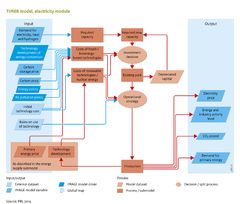Energy conversion/Description: Difference between revisions
Jump to navigation
Jump to search
No edit summary |
No edit summary |
||
| Line 1: | Line 1: | ||
{{ComponentDescriptionTemplate | {{ComponentDescriptionTemplate | ||
|Status=On hold | |Status=On hold | ||
|Reference=Hoogwijk, 2004; Van Vuuren, 2007; Hendriks et al., 2004b; | |Reference=Hoogwijk, 2004; Van Vuuren, 2007; Hendriks et al., 2004b; | ||
|Description=The [[TIMER model]] includes two energy conversion submodels: the electric power generation model and the hydrogen generation model. Here, the focus is on a description of the electric power generation model (The flowdiagram on the right also shows only the electricity model). The hydrogen model follows a similar structure, and its key characteristics are briefly discussed in this Section. | |Description=The [[TIMER model]] includes two energy conversion submodels: the electric power generation model and the hydrogen generation model. Here, the focus is on a description of the electric power generation model (The flowdiagram on the right also shows only the electricity model). The hydrogen model follows a similar structure, and its key characteristics are briefly discussed in this Section. | ||
Electric power generation | Electric power generation | ||
As shown in the flowdiagram, two key elements of the electric power generation model are the descriptions of the investment strategy and the operational strategy within the sector. A challenge of simulating electricity production in an aggregated model is that, in reality, electricity production depends on a whole range of complex factors, such as those related to costs, reliance, and the time it takes to switch on technologies. Modelling these factors requires a very high level of detail. Therefore, IAMs such as TIMER concentrate on introducing a set of simplified, meta relationships ([[Hoogwijk, 2004]]; [[Van Vuuren, 2007]]). | As shown in the flowdiagram, two key elements of the electric power generation model are the descriptions of the investment strategy and the operational strategy within the sector. A challenge of simulating electricity production in an aggregated model is that, in reality, electricity production depends on a whole range of complex factors, such as those related to costs, reliance, and the time it takes to switch on technologies. Modelling these factors requires a very high level of detail. Therefore, IAMs such as TIMER concentrate on introducing a set of simplified, meta relationships ([[Hoogwijk, 2004]]; [[Van Vuuren, 2007]]). | ||
==Total demand for new capacity== | ==Total demand for new capacity== | ||
Revision as of 15:06, 9 December 2013
Parts of Energy conversion/Description
| Component is implemented in: |
|
| Related IMAGE components |
| Projects/Applications |
| Models/Databases |
| Key publications |
| References |
